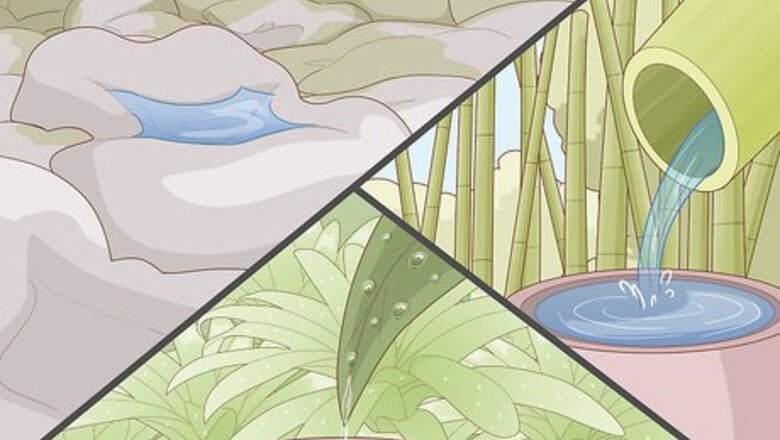
views
- Find water by collecting rainfall from leaves, boiling water from streams, and making solar water stills with a container and a plastic sheet.
- To find food, look for safe and recognizable fruits, build simple hole-in-the-ground traps to catch animals, and make a 4-pronged bamboo spear to fish.
- Build a lean-to by propping a long-straight stick diagonally against a tree; place shorter sticks against its sides, and cover them with leaves for shelter.
- Cover your head and neck for protection; stick by the plane if you’re in a crash, or use familiar landmarks and follow water sources downstream on foot.
Finding Water
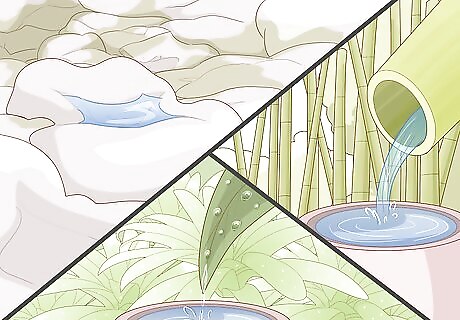
Collect rainfall from leaves and bamboo stalks. Look for large leaves that collect rainfall and bend them into a funnel to pour the water into a bottle or straight into your mouth. Bend bamboo stalks to let the water that collects in the compartments flow out into a container or break the bamboo compartment off at the line that goes across the stalk to use it as a water bottle. You could also look for rock formations that form natural pools and collect rainwater, but it is best to do this after a fresh rainfall to avoid pools that have been sitting for a long time and may be contaminated with bacteria. If you don’t have a water bottle or other container to collect water, try to find other natural containers in the jungle such as a coconut shell or piece of wood shaped like a bowl. You can also leave these items out when it rains to collect the fresh water.
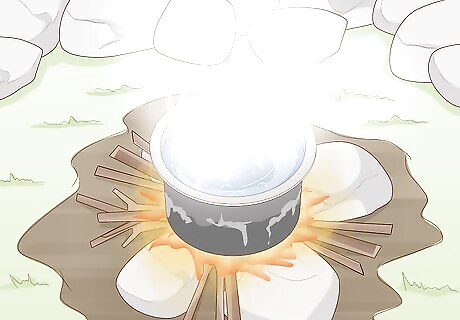
Boil water from streams to kill any bacteria. Look for running streams to find fresh water. Filter out any particles through a sock, shirt, or other fabric, then start a fire and boil the water to kill bacteria that can make you sick. If you don’t have a pot to boil water in, then you can use a tin can, single-walled stainless steel water bottle, or any other metal container. If you have no way of making a fire or boiling the water, then you should avoid drinking water from streams. It can be contaminated with many types of bacteria from animals that will make you very sick. Always avoid drinking water from stagnant pools as the water is likely contaminated.
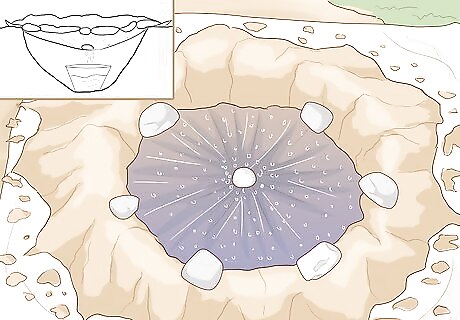
Make a solar water still with a container and a plastic sheet. Dig a hole in an area that receives at least some direct sunlight and put a container, such as a water bottle or can, in the middle of the hole. Fill the space between the sides of the hole and the container with wet leaves. Place a plastic sheet over the top of the hole and put rocks or other heavy objects around the edges to hold it in place. Put a small stone in the middle of the sheet above the container. The plastic sheet will accumulate condensation that will drip down the underside of the sheet and into the container. This water is distilled and safe to drink. You can use natural containers such as bamboo or a coconut shell if you don’t have a bottle or can. A solar still does not collect large amounts of water. It should be used as a supplemental source of water rather than a primary source.
Getting Food
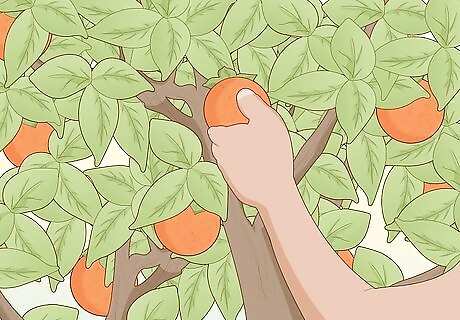
Look for fruits and plants that you recognize and are safe to eat. Jungles are full of tropical fruits and edible plants if you know what to look for. Don’t try eating any plants that you don’t recognize because they could be poisonous. Look for common jungle fruits you have eaten before such as bananas, pineapples, oranges, passion fruit, coconuts, mangos, and avocados. Bamboo and palms are also safe to eat and commonly found in jungles. Almost all types of palm trees have an edible "heart" that you can harvest from the inside of the tree. You can eat bamboo shoots, in other words bamboo that is just starting to grow, but you should boil them before eating them as they are quite tough.
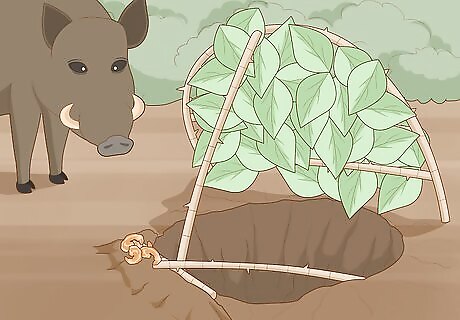
Build simple hole-in-the-ground traps to catch animals. Dig a hole in the ground and cover it with something like a large leaf. Put a piece of fruit in the middle as bait. When an animal comes to take the fruit, they will fall in the hole and you can kill it, skin it, and cook it to eat it. Make sure that the hole is deep enough that the animals can’t get out once they fall in. Animals you could trap in the jungle include monkeys, lizards, and rodents, and other small mammals. Don’t waste your energy trying to hunt for food unless you are an experienced hunter and really know what you are doing. Setting traps is much more efficient and you just have to wait for the animals to come to you instead of wasting energy and time trying to hunt them. If you don’t have a knife to skin or butcher animals, then try to find sharp rocks to use as tools. You can also use the rocks to carve knives and spears out of bamboo or other branches.
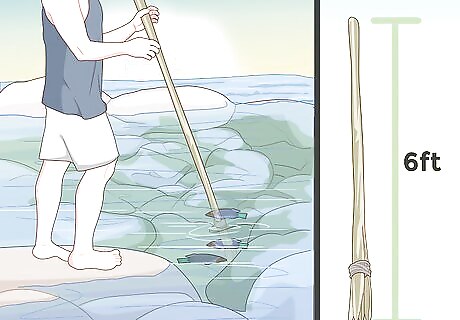
Make a 4-pronged bamboo spear to fish with. Find a 6-ft (1.8 m) stalk of bamboo and cut 4- 6 in (15.24 cm) slits into 1 end of it with a knife or sharp rock. Weave a piece of vine into the slits to separate the tip of the bamboo into 4 prongs and sharpen them with a knife or a sharp rock. To fish with your spear, stand on a rock in the middle of a stream or wade into knee-deep water. Stand still and wait until you see a fish, then spear it with the pronged end of the bamboo and pin it to the ground of the stream.
Building Shelter
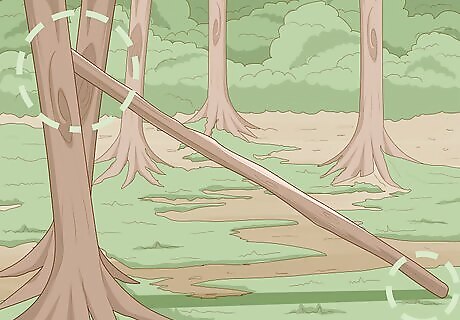
Find a long, straight stick and lean it against a tree to create a lean-to. Make sure the stick is long enough that you will fit under it to sleep. Place one end against the trunk of a tree, high enough that you can fit under it, and the other end against the ground. Check around the tree and look in any cracks with a flashlight, if you have one, to make sure there are no snakes, large spiders, or other animals.
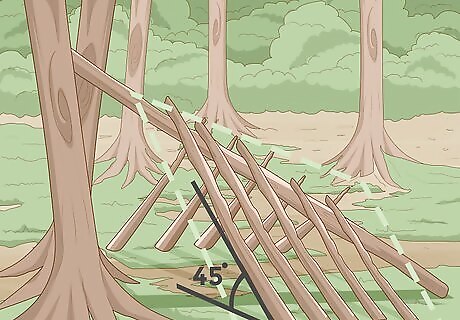
Place shorter sticks and branches against the sides of the center pole. Line the length of the middle stick with branches going outward towards the ground at a 45-degree angle. The more sticks you can find to place along the sides, the easier it will be to cover your shelter. You can tie the sticks to the center pole and to each other where they meet in the middle with pieces of vine to make a more stable shelter.

Cover the sides with leaves and foliage to cover the lean-to shelter. Find large leaves and lay them over top of the frame you built. Cover the shelter as well as you can to protect you from the elements and keep animals out. Make sure to build a shelter each night before it gets dark and always sleep at night to rest.
Avoiding Dangers

Be careful when you cross rivers and use a stick for balance. Rivers contain many perils such as slippery rocks and strong currents that can lead to injuries. Choose the shallowest point you can find to cross and avoid crossing anything deeper than knee deep unless you have to. Keep in mind that rivers and other waters may contain dangerous animals as well. Watch out for things like leeches and larger threats like crocodiles.
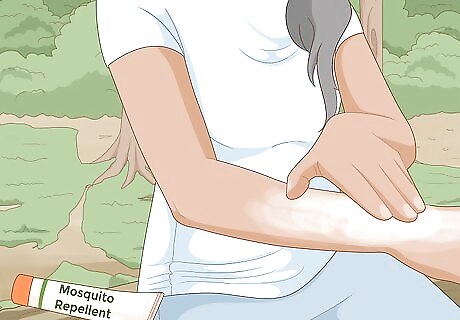
Protect yourself from mosquito bites that could give you a disease. Always wear mosquito repellent, if you have it, and keep your skin covered as much as possible with your clothing. Rub mud on your exposed skin to protect it from mosquito bites as well. Mosquitoes can carry diseases in the jungle such as malaria, yellow fever, and dengue fever. If you get sick with any of these, it will be very hard to keep moving and survive in the jungle.

Cover your head and neck to avoid heatstroke, sunburn, and dehydration. Keep all of your clothes on and wrap a shirt, or any other spare fabric, over your head and neck to protect yourself from the sun. Dehydration and heat exhaustion are your worst enemies when surviving in the jungle. Stop and rest if you feel like you are overheating, or avoid traveling during the hottest parts of the day and in direct sunlight.
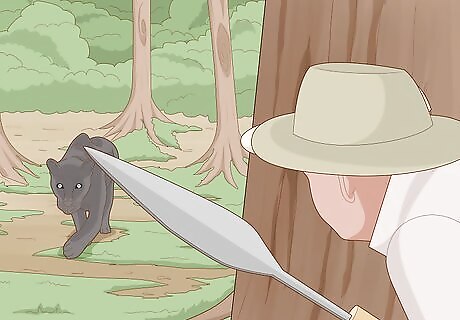
Watch out for predators and carry something to protect yourself as a last resort. Move quickly and quietly so that you don’t seem like a threat to predators. When you see a potential predator, such as a large jungle cat, back slowly away and be prepared to fight if they attack. Make a spear by carving one end of a bamboo shoot or a stick with a knife to carry as a weapon and use as a last resort. The main jungle predators to watch out for include panthers, jaguars, leopards, or tigers, depending on what part of the world you are in. Also watch out for underwater predators such as alligators, caimans, crocodiles, and anacondas. You also need to watch out for smaller animals that can harm you, such as snakes and spiders. Try not to grab any vegetation with your hands where animals could be lurking and end up biting you.
Getting out of the Jungle
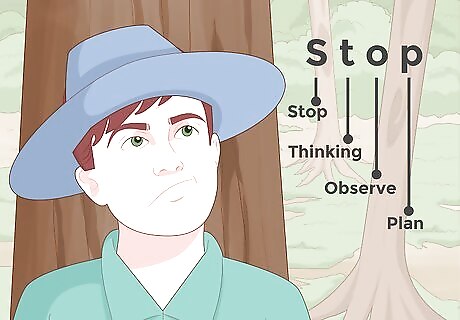
Stop, think, observe, and plan. Remember the acronym STOP and follow it when you get lost in the jungle. Stop to rest and think about where you came from, observe your surroundings, try to orient yourself, then plan how you are going to get out or get rescued. Try your best not to panic when you find yourself in a survival situation. You need to clear your mind of emotions like fear in order to think logically and increase your odds of survival.
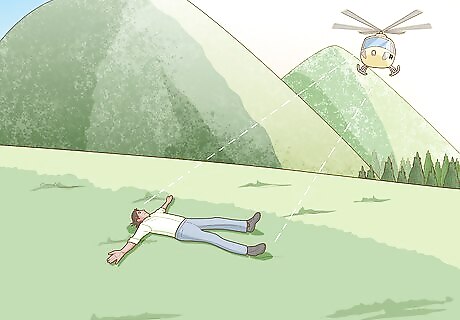
Stay with the plane if you are stuck in the jungle because of a plane crash. Rescuers may come looking for you. Stay at the crash site unless you are sure nobody is coming for you, then you need to start moving to get out of the jungle. Listen for sounds like helicopters or planes, and try to stay in a clear area where you can be seen.
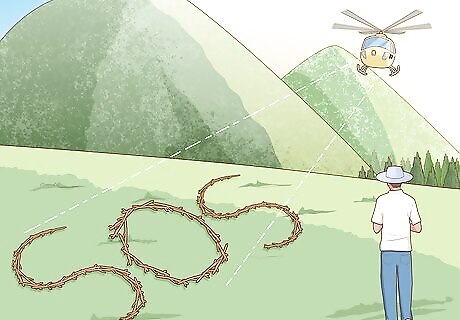
Create a message that can be seen from the air if you're trying to get rescued. If you do not have a crash site, you can still look for clear areas and spell out “SOS” using sticks and stones so it can be seen from the air by any passing planes or helicopters. This will increase your chances of someone coming to look for you.
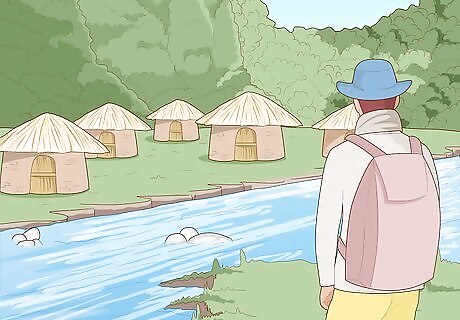
Think about where you came from if you got lost on foot. Orient yourself using any landmarks you remember, such as a hill in the distance or a river. Get back to a point you remember to find the trail again or head back in the direction of a village that you came from. Check around you for evidence that shows which direction you came from, such as footprints or broken branches and foliage. Follow signs like these to get you back to a trail or village.
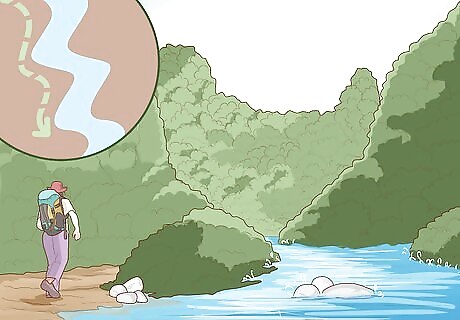
Move straight in one direction and follow water sources downstream. Choose something in front of you to walk towards if you don’t have a water source to follow so that you don’t get disoriented and walk in circles. Get to a stream or river and keep moving downstream to find civilization. Look for obvious animal trails that are going in the same direction as you and follow them to try and find a water source. Streams eventually lead to rivers, and rivers eventually lead to civilization, so following streams is your best chance of getting out of the jungle and getting rescued.

















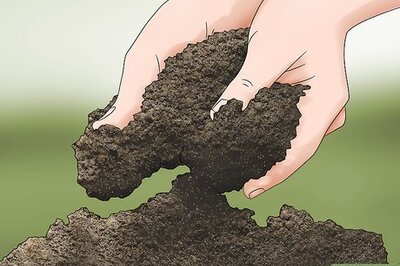
Comments
0 comment